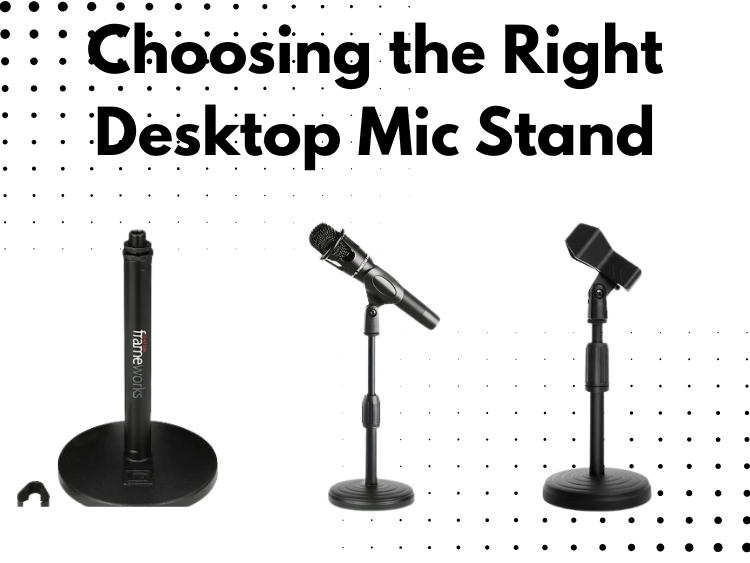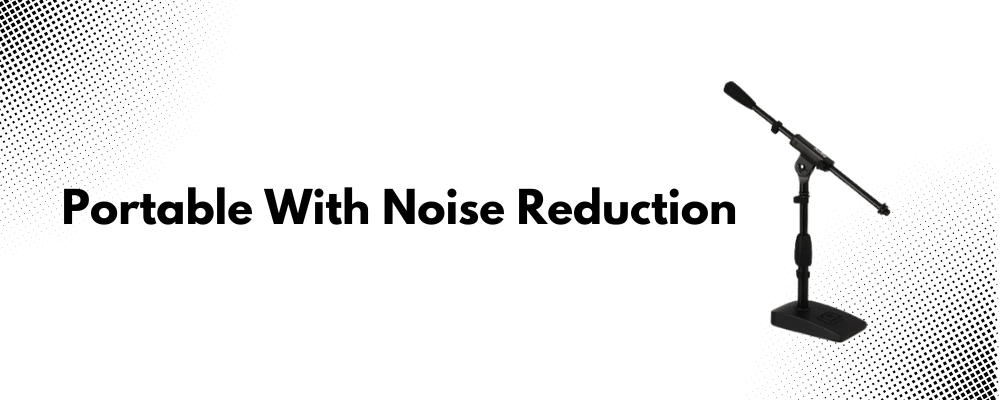A desktop mic stand does more than just hold your microphone—it defines your recording experience. The right stand keeps your setup stable, minimizes unwanted noise, and ensures your mic is positioned exactly where you need it.
With options ranging from compact tripod stands to weighted-base designs, finding the right fit can feel overwhelming. Do you need something sturdy for professional recordings or a flexible stand for casual calls?
This guide breaks it all down. From stability to adjustability, we’ll cover everything you need to know to choose the perfect desktop mic stand for your setup. Let’s dive in.
Understanding Desktop Mic Stands
A desktop mic stand is a compact stand designed to keep your microphone stable on a flat surface. It helps position your mic at the right height and angle while minimizing unwanted movement or vibrations. Unlike floor stands, these are ideal for desks, workstations, and recording setups where space is limited.
The right stand enhances sound quality, improves comfort, and ensures consistency in recordings. Whether for podcasting, streaming, or video calls, a well-chosen mic stand prevents handling noise and keeps your mic secure.
Key Factors to Consider
If you are looking forward to purchasing a desktop mic stand, you should consider the following factors at first:
Stability and Build Quality
A stable mic stand prevents accidental tipping and reduces vibrations. Consider:
- Weighted Base vs. Tripod Stands – Weighted bases offer better stability, while tripod stands provide flexibility and foldability.
- Material Matters – Metal stands are more durable, while plastic ones are lightweight but less sturdy.
- Rubberized Feet – Helps prevent slipping and absorb minor desk vibrations.
Adjustability and Height Range
Not all mics or setups require the same height or angle. Look for:
- Telescoping Stands – Adjustable height for different speaking or recording positions.
- Gooseneck Stands – Flexible positioning for quick adjustments without knobs or locks.
- Tilt and Swivel Options – Helps achieve the best mic angle without moving the base.
Compatibility with Your Microphone
Not all mic stands support every microphone. The right fit ensures stability and optimal performance. Key factors to check:
- Thread Size – Most stands use 3/8″ or 5/8″ threads. Use an adapter if needed.
- Weight Capacity – Heavier mics need sturdier stands to prevent tipping.
- Shock Mount and Clip Compatibility – Some mics require special mounts; ensure your stand supports them.
A mismatch between your stand and mic can lead to poor positioning, instability, or the need for extra accessories. Always check specifications before purchasing.
Space and Portability
Your workspace dictates the best stand for you. If you have limited desk space or need a portable setup, consider:
- Compact Designs – Weighted-base stands take up less space, while tripod stands need more room.
- Foldability – Tripod stands often collapse for easy storage and transport.
- Cable Management – Some stands include clips or channels to keep cables tidy.
A well-sized stand keeps your workspace organized and clutter-free while maintaining functionality.
Isolation and Noise Reduction
A mic stand should do more than just hold your microphone—it should also help reduce unwanted noise. Vibrations from your desk can travel through the stand, affecting audio quality. Here’s what to consider:
- Shock Mount Compatibility – A shock mount absorbs vibrations, preventing desk bumps from reaching your mic.
- Dampening Materials – Some stands feature rubber padding or foam to reduce surface noise.
- Weighted Bases – Heavier stands absorb minor vibrations better than lightweight ones.
A stand with good isolation features ensures a cleaner, more professional sound, especially for recording or live streaming.
Best Desktop Mic Stand Types for Different Uses
Desktop mic stands aren’t a one-shoe-fits-all. Based on your needs, you may require specific changes if you are looking forward to any of these activities:
For Streaming and Podcasting
- A sturdy, adjustable stand ensures the mic stays in place during long sessions.
- Shock mount support helps minimize vibrations from desk movements.
- Gooseneck or telescoping designs allow precise positioning.
For Musicians and Vocalists
- Flexible positioning helps capture instruments and vocals accurately.
- A tilting or rotating stand allows quick mic angle adjustments.
- Tripod-based designs offer better balance for dynamic performances.
For Conference Calls and Workstations
- Compact, low-profile stands keep the mic stable without cluttering the desk.
- A fixed-height stand works best for consistent speaking positions.
- Cable management features help keep the workspace organized.
Conclusion
Choosing the right desktop mic stand isn’t just about holding your microphone—it’s about ensuring stability, sound quality, and ease of use. A poorly chosen stand can lead to unwanted noise, awkward positioning, and unnecessary frustration.
Before making a decision, consider your workspace, mic compatibility, and recording needs. A sturdy weighted base suits professional setups, while an adjustable gooseneck stand works well for flexible positioning. If portability is a priority, a foldable tripod stand may be the best choice.
A well-matched mic stand enhances your setup, making your recording or streaming experience seamless. Invest in one that supports your workflow and delivers consistent results.
If you liked this article, consider reading:



